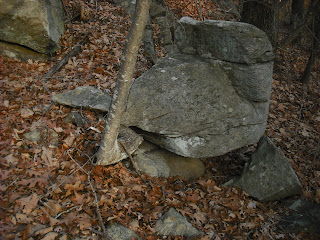On the side of the steep hill overlooking the swamp, a rocky slope faces southwest. Near the bottom stands this propped boulder. The boulder and base have different textures and colors, indicating they weren't broken from one large boulder.
Note how neatly the boulder fits on the base at the points of contact. The lower edges of the boulder look like they were chipped away to create this effect.
At the top of the slope, this massive pile of rocks is neatly stacked on top of a couple of boulders.
The rocks are similar in size, and have flat faces. A small slab resembling a manitou is standing in the middle of the pile. Someone may have placed it there to keep it from getting broken. Although this pile could have started as a donation pile, its later purpose is suggested by its location at the end of a long farm wall.
My guess is that the rocks were broken up from larger stones and stored here for use in further wall building. A farmer, or Natives working for a farmer, broke up these rocks from boulders at the top of the hill and stacked them here. Following the wall, I see this impressive propped boulder.
It looks like it is in danger of tumbling down the hill. Note the sharp edges on the planes facing the camera. It looks like pieces were broken off.
Here is the front view. There is a large concavity to the right in the boulder, suggesting some deliberate alteration. Many of the propped boulders I have seen look like stone was chipped away to create the typical smooth, oblong shape. The boulder is a light, smooth stone, while the base is foliated granite. This is probably a glacial erratic, dropped here by a glacier 17,000 or more years ago. Glacial erratics such as Hipses Rock often had some significance to the Native Americans, at least as landmarks and meeting points. In front of it, a small piece of quartz, and then a large chunk of quartz.
And finally, on the trail back to the marsh, a nearly buried piece of quartz next to the stick, and a young bent tree.
The first two pieces of quartz have not been sitting here long, since they are on top of the ground. This area was farmed in the 1800s, then abandoned to the forest. The propped boulders suggest Native use, and the piled rocks and walls, farm use. The quartz and bent trees suggest Native remembrance.



























